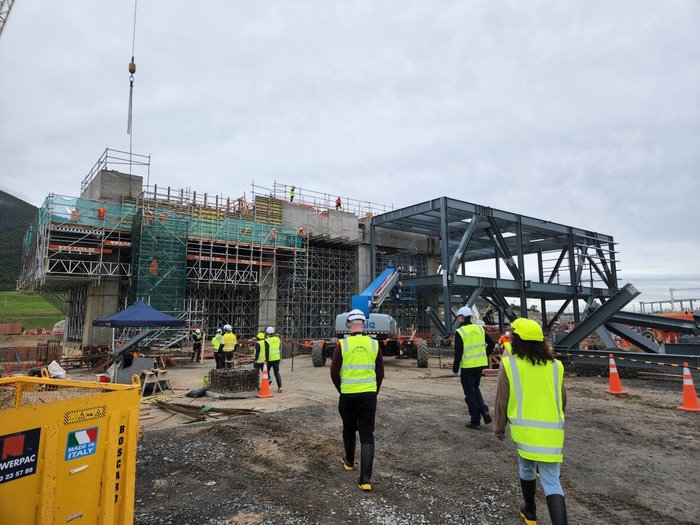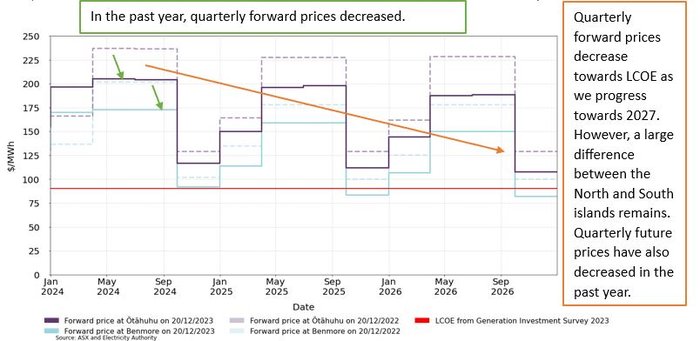Eye on electricity
The levelised cost of electricity
- Generation

What is LCOE and why is it important?
In New Zealand, more electricity generation is needed to meet future electricity demand and replace retiring thermal power plants. The initial build costs of new generation often total millions of dollars, so investors need assurance they can recover the cost of their investments.
A useful metric when analysing new generation is the levelised cost of electricity (LCOE). This compares lifetime costs and generation output across different technologies, like wind, solar, geothermal, hydro and thermal fuel sourced generation, like coal and gas turbines. In general, a lower LCOE is more attractive for developers as, on average, the asset can pay itself back with lower average electricity prices.
How is LCOE calculated?
Most calculations of the LCOE for a particular technology are the sum of the costs over the lifetime divided by the sum of electrical production over the lifetime. This calculation gives a value of the electricity produced as $/MWh.
Levelised cost of electricity (LCOE) = total lifetime costs ÷ total lifetime electrical production
Lifetime costs vary between technologies and build locations, but generally include initial investment expenses (like buying land and equipment) and lifetime operation, maintenance and fuel costs. The LCOE for different technologies also varies over time, for example as fuel costs fluctuate or lifetime electrical production improves as technologies mature.
Renewable generation typically has lower operating costs compared to thermal generation. Also, electricity output is variable for renewable generation. So, the LCOE for renewables is highly dependent on the estimated capacity factor1, which often varies with location.
The LCOE should be used with caution, especially when comparing the LCOE from different studies. The underlying assumptions about investment cost and asset lifetime can differ substantially which impacts the LCOE produced. Also, assumptions about changes in taxes and government subsidies may or may not be included. It’s always a good idea to check the methodology of each study before making comparisons or relying on the information contained in the study
How does the LCOE compare to forward electricity prices?
In January 2024, the Electricity Authority Te Mana Hiko2 reported that in the last 18 months New Zealand had almost doubled the amount of new renewable generation committed to be built. The Generation Investment Survey also found the LCOE for best new electricity supply3 in New Zealand to be roughly $90/MWh (in 2023 NZ dollars4). This is an increase from $86/MWh (in 2023 NZ dollars) the year before. This increase reflects a higher cost of loans and tight global supply chains.

Forward prices reflect overall expectations of future electricity prices and. See more in this explainer on the forward electricity market. In general, long-term forward prices and the LCOE for new generation should converge in a competitive market. Developers build new generation if they anticipate future electricity prices will cover their expected costs ie, if they see future electricity prices are, on average, higher than their expected LCOE.
Forward prices between 2024 and 2025 remain higher than the LCOE for new generation, as seen in Figure 1. While new generation is expected in New Zealand in 2024 and 2025, project delays, low inflows into hydro storage lakes and outages have contributed to expectations of tighter supply of electricity in these years. This is reflected in the higher forward prices for these years. However, forward prices decline in 2026 and 2027, according to the latest LCOE estimate by Concept Consulting, particularly at Benmore Power Station. Forward prices at Ōtāhuhu, however, remain higher than those at Benmore and still slightly higher than the LCOE5(red line) in 2026. However, forward prices for each quarter between 2024 and 2026, at both Ōtāhuhu and Benmore, have decreased since the 2022 survey.
Regular collection and transparency of the new generation building pipeline is important to enable the Electricity Authority to monitor both competition and long-term security of supply. The Electricity Authority is working to facilitate its data collection in a cost-effective and timely way. This includes collecting development costs so that we can continue to monitor LCOE versus forward prices.
1. Estimates how often the generation is running at maximum output.
2. With Concept Consulting.
3. Includes geothermal, wind and solar.
4. If the generation was being built to supply baseload electricity at Otahuhu. See more details in the Generation Investment Survey
5. From the 2023 Generation Investment Survey
Related News
Centralised wind and solar forecaster contract awarded
The Electricity Authority has awarded a contract to provide centralised wind and solar forecasting services to DNV Services.
Battery energy storage systems roadmap released
We have published a draft two-year roadmap that sets out our work to support investment in battery energy storage systems (BESS). BESS will become increasingly…
Submissions published on frequency-related Code amendment proposals
We have published submissions on our proposal to amend Part 8 of the Code to address increased frequency variability in New Zealand’s power system.